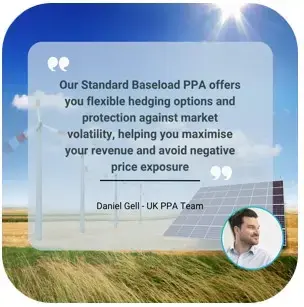
Understanding the Impact of Negative Prices on your PPA Revenue
Published: 30/06/25
2-minute read
Are you feeling the pressure from fluctuating electricity prices and wondering how to safeguard your revenue amidst these uncertainties? If so, you're not alone. The UK power market is experiencing increased instances of negative prices, driven by several factors that can complicate your revenue optimisation strategies.
Following on from his blog on Understanding PPAs, Daniel Gell briefly dives into the challenges of negative power prices, and offers valuable guidance on how TotalEnergies Gas & Power and our UK PPA Team can help you strike the optimal balance between different PPA options to ensure you thrive in this evolving energy market.

Firstly, we need to understand some of the reasons driving this forecast for increased negative prices in the UK power market:
High renewable generation: The UK has a large and growing share of renewable energy sources like wind and solar which are intermittent and can generate an excess of power during certain times, particularly on sunny or windy days. When this happens, the grid can become oversaturated.
Low Demand: Demand for electricity is generally lower during weekends, holidays and at night. When high levels of renewable generation coincide with low demand, there is a significant surplus of electricity on the grid which can lead to negative prices.
Inflexible Generation: Some traditional power stations, like fossil fuelled or nuclear plants, are not able to adjust their output rapidly enough to match fluctuating demand which can further contribute to oversupply.
Support Schemes: Schemes incentivise renewable generators to produce electricity, as they are sometimes guaranteed a minimum price per unit of electricity produced, usually from their ROC (renewable obligation certificate) or FiT (feed in tariff) accreditation. This has changed with the later iterations of the latest support scheme, but under other historic subsidies typically have no incentive to curtail production during negative periods.

How can TotalEnergies help you to combat challenges to optimise your revenue opportunities?
Indexed linked PPAs have their benefits, as do fixed price PPA variants, but with the former giving you direct exposure to negative prices and the latter forcing you to lock-in/hedge a fixed price for typically one to two years on a single day. So, how can you strike the perfect balance between the two?
TotalEnergies Standard Baseload PPA offers you a flexible PPA in which to protect and maximise the revenue from your generation, giving you the opportunity to secure a positive price with your forward hedges, whilst not requiring you to hedge large amounts of long-term volume at the point of contract execution. This is the case with a fixed price PPA where you are simply a 'price taker' at the point of execution and at the mercy of the market on that day.
With the unique protection from our fixed £ per MWh risk and shape discount throughout the PPA contact duration, there are no exposures to market pricing implications from over and under production once your price is locked in ahead of delivery. With the ability to make multiple to make multiple lock-ins/hedges at a time of your choosing, the Standard Baseload PPA provides increased opportunity to maximise your revenue whilst also avoiding exposure to negative market prices.
Final thoughts...
Navigating the complexities of the PPA market and the challenges posed by negative prices can be daunting. However, with the right strategies and support from the UK PPA Team, you can optimise your revenue and maintain profitability. By leveraging flexible PPA arrangements and innovative solutions, you can ensure a stable future for your energy generation ventures.
If you'd like to explore the Standard Baseload PPA in more detail, please visit our webpage. For further support and expert advice, get in touch with the PPA Team at TotalEnergies Gas & Power, we're here to help or contact me directly on: [email protected].
Keep an eye on our Blog page for further updates, and follow us on LinkedIn to keep up to date with all our latest content.